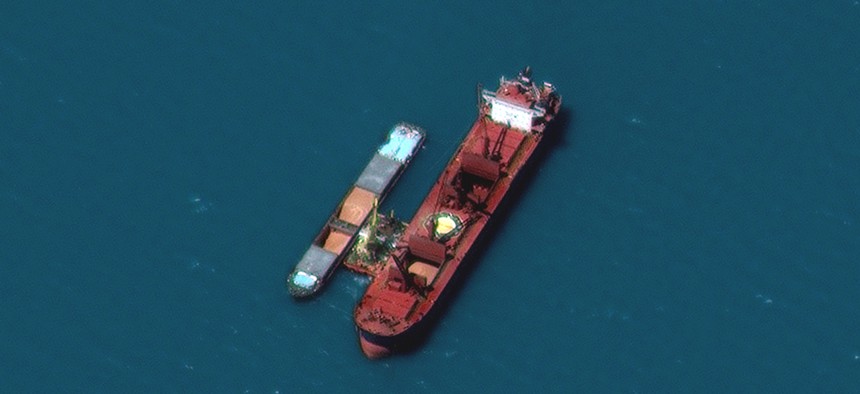PATRICK TUCKER

According to analysts and observers, Russia is exporting “more oil than ever” despite Western attempts to cut off one of Moscow’s economic lifelines and new tools and technologies that make it harder to hide energy shipments. Some governments, it seems, are determined to buy Russia’s oil even if they don’t support its war on Ukraine.
Robin Brooks and his colleagues at the Institute of International Finance, or IFF, built a database to track the movement of oil tankers out of Russian ports. That’s not as easy as it sounds because those tankers “are registered and flagged all over the place,” to hide their actual ownership, according to an August 25 briefing note from the association obtained by Defense One. “We trace the ultimate owner through shell companies as needed, which provides some perspective on who has been helping to ship Russian oil around the world,” the note says. “This work concludes that tanker capacity out of Russia has been robust overall.”
Brooks, the IIF’s chief economist, put it more directly on Twitter: “Russia is exporting more crude than ever.”
That may come as a surprise. Many Western oil companies ditched Russian crude after the Kremlin launched its illegal offensive on Ukraine in February. Energy prices soared past $120 a barrel; many speculated that the price could hit $150 by year’s end.
But the global benchmark price for crude oil has fallen back to $90 a barrel—and Russia is selling it for about 20 percent less. China, India, and even NATO member Turkey are buying more Russian oil than ever. Now U.S. Treasury Secretary Janet Yellen is pushing G7 nations, which together comprise about 30 percent of the global economy, to place a price cap on Russian oil, which she says would squeeze Moscow and keep global energy prices in check.
But just as Russia has found willing buyers, they’ve also found willing shippers. “Attracted by higher tanker rates, Greek-owned tankers have stepped in to increase Russia's capacity to sell oil to the global market,” Jonathan Pingle, associate research analyst with the IIF, said in an email. “For each crude tanker we track out of Russian ports, we scrape for the location of the beneficial owner's headquarters. From this, we've found that Western-owned tankers have accounted for an increasingly large portion of Russia's shipping capacity. Greek-owned vessels have provided 55 percent of capacity since the start of the war, compared to 35 percent in years prior.”
New Tools to Spot Russian Oil Movers At Sea
Russia may still have buyers for its crude but those transactions won’t be as invisible as the participants may want. In addition to new tools like the IIS database, satellite imagery and pieces of other open-source information are making it easier for Western observers to track Russian oil movers.
Satellite image provider Maxar has a tool called Crows Nest that can track ships that are trying to avoid detection. That’s been very useful in the effort to stop Russia from smuggling Ukrainian grain.
Bryan Smith, Maxar’s director of maritime products, said the technique uses radar to scout wide areas for potential targets. Maxar then uses its numerous high-resolution satellites to survey the ships, even those that are trying to “go dark” by turning off their automatic identification system, or AIS. They use AI to predict things like speed and momentum so that they know where to point the satellite during the next revisit, “which will allow for us to maintain chain of custody,” he said.
Toward the end of the year, Maxar plans to launch the first two WorldView Legion satellites, another pair two months after that, and another two a couple months later. The new satellites will allow Maxar to triple its revisit of certain spots to up to 15 times per day.
Smith said that the number of calls they’ve received from intelligence entities looking to track Russian oil has gone up considerably, not just in the Black Sea. Russian smugglers are resorting to strange but futile tactics to avoid being seen.
One time, he said, Maxar satellites found a Russian oil vessel that was properly broadcasting its identity via the AIS tracking system—and offloading oil to a ship that was not. “You can see vessels next to each other. You can see the pipe where the oil was being actually, you know, offloaded onto a dark vessel. And then, interestingly enough, there was another dark vessel that was kind of approaching. And it looks like it's almost, like, lining up, like it was a gas station.”
No comments:
Post a Comment